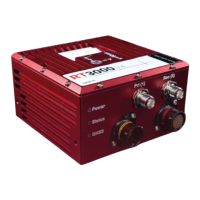Oxford Technical Solutions Ltd Page 85 of 110
Initialisation process
Before the RT can start to output all the navigation measurements, it needs to initialise itself. In order to
initialise, the RT needs all the measurements listed in Table 28.
Table 28: Quantities required for initialisation
Time Measured by internal GNSS
Position Measured by internal GNSS
Velocity Measured by internal GNSS
Heading Approximated to course over ground (with large error) when the vehicle moves.
Dual antenna models have the option for static initialisation which does not
require any movement
Roll, pitch Vehicle Level option: assumed zero with a large error. Otherwise: estimated
over first 40 s of motion with large error
The system will start when it has estimates of all of these quantities. Course over ground will be used as the
initial heading when the system exceeds the value set as the initialisation speed (default of 5 m/s), unless
static initialisation has been selected. If the system is mounted level in the vehicle, then the Vehicle Level option
will enable the system to start immediately. Otherwise the system takes about 40 s to find approximate values
for roll and pitch.
For the initialisation process to work correctly, the RT requires the user to tell it which way it is mounted in the
vehicle, otherwise the course over ground will not be close enough to the heading.
Real-time outputs
During the initialisation process the system runs 1 s behind, allowing GNSS information to be compared to
information from the inertial sensors. After initialisation the system has to catch-up from this 1 s lag. It takes
10 s to do this. During the first 10 s the system cannot output data in real time, the delay decays to the specified
latency linearly over this 10 s period.
The system turns the Status LED orange to show the outputs are not real-time. When the system is running in
real time this LED is green.
Warm-up period
During the first few minutes of operation the system will not conform to specification. During this period the
Kalman Filter runs a more relaxed model for the sensors. By running a more relaxed model the system is able
to:
Make better estimates of the errors in the long term (if it does not get these correct then they become more
difficult to correct as time goes on).

